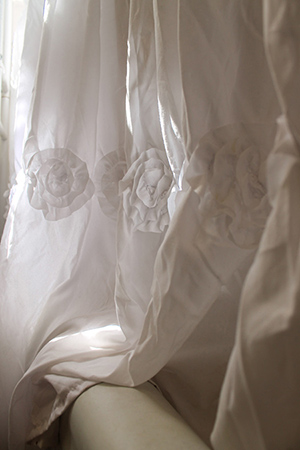UAB Callahan Eye Hospital Emily Cox-Oldham, from the series “The Slide Project,” 2019 will feature art created by University of Alabama at Birmingham students in a series of rotating exhibitions.
Emily Cox-Oldham, from the series “The Slide Project,” 2019 will feature art created by University of Alabama at Birmingham students in a series of rotating exhibitions.
The first exhibition will feature the works of two students, Caroline Myers and Emily Cox-Oldham, in the College of Arts and Sciences’ Department of Art and Art History. In addition to exhibiting their work, Callahan has generously provided an honorarium to both students. The work will be on view through summer and fall and can be seen on the third floor of the clinic during regular business hours.
Art is a universal medium of expression, bridging gaps across language, time and culture, says Jessica Martindale, Callahan Eye Hospital communications manager. Art is about more than you can see, and this is an important concept for the patients at Callahan Eye Hospital & Clinics, she says.
“The value of art goes beyond paint, color, canvas or clay and is instead found in the connection between the individual and the piece, no matter their physical ability,” Martindale said.
The founder of the hospital, Alston Callahan, M.D., appreciated art, and was the primary driving force behind acquiring “Complex Vision,” a large-scale installation by artist Yaacov Agam, known as the father of kinetic art. “Complex Vision” has been the visual landmark of UAB Callahan Eye Hospital since November 1976 and adorns the front of the building.
“It is important that we continue to build upon those values of Dr. Alston Callahan, which is why UAB Callahan Eye Hospital & Clinics has partnered with the UAB Department of Art and Art History to build a relationship and keep original artwork alive in our facility,” Martindale said.
In the spirit of “Complex Vision,” works on view by UAB photography students Caroline Myers and Emily Cox-Oldham display sophisticated points of view that thoughtfully consider how light and line, color and texture can be captured by the camera and translated to meaningful, curious works of art.
 Caroline Myers, from the series "Chasing Light,” 2019As a junior double major in Studio Art and Psychology at UAB, Cox-Oldham is interested in the intersection of art and mental health and the possibilities of therapeutic creative expression. Cox-Oldham’s “The Slide Project” follows in the long tradition of photographic typologies, where the artist selects a single subject matter in order to discover nuanced changes amid repeating forms. Her large-scale images explore the texture and form of children’s playground slides. Across the playful, lighthearted series of photographs, bright color fills the field of view as the artist’s close-up point of view abstracts the familiar and transforms scuffs and scrapes into painterly, gestural marks. The pictures provide a lively yet thoughtful record of the passage of time and the many children who have made their mark on the slides.
Caroline Myers, from the series "Chasing Light,” 2019As a junior double major in Studio Art and Psychology at UAB, Cox-Oldham is interested in the intersection of art and mental health and the possibilities of therapeutic creative expression. Cox-Oldham’s “The Slide Project” follows in the long tradition of photographic typologies, where the artist selects a single subject matter in order to discover nuanced changes amid repeating forms. Her large-scale images explore the texture and form of children’s playground slides. Across the playful, lighthearted series of photographs, bright color fills the field of view as the artist’s close-up point of view abstracts the familiar and transforms scuffs and scrapes into painterly, gestural marks. The pictures provide a lively yet thoughtful record of the passage of time and the many children who have made their mark on the slides.
Myers is a rising junior and a Bachelor of Fine Arts candidate in the Department of Art and Art History. Myers’ “Chasing Light” explores the magical way in which light can transform the simplest forms into dramatic, ethereal moments of beauty. By capturing warm, dappled light and deep, enveloping shadows across commonplace objects and domestic spaces, her photographs draw viewers into a series of contemplative yet fleeting moments. The quiet compositions are full of warm pastel colors gently touched by soft lines, shapes and textures that transcend the subject matter and thoughtfully reveal beauty in the quotidian.
Myers and Cox-Oldham produced their projects during their coursework in the UAB Department of Art and Art History’s photography area, led by Professor Sonja Rieger, MFA. It’s a pleasure to see their work installed in the Callahan Eye Hospital, Rieger says.
“The goal of the UAB Department of Art and Art History photography program is to expose students to professional practices in the field of fine art and commercial photography and to encourage students to continue a connection to the arts throughout their lives,” Rieger said. “This exhibition provides a wonderful opportunity for our students’ professional development and provides a platform to share the exciting work being made in the UAB photography program.”